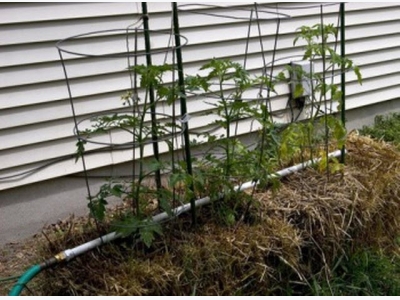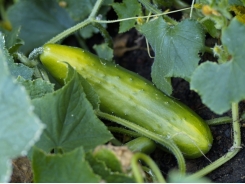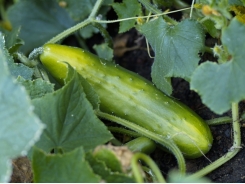Expert Tips for Growing Garden Tomatoes – Straw Bale Culture

Among basic advantages of straw-bale cultivation is isolation from soil-borne troubles of which tomato mosaic virus may be among the most destructive. Root debris from a previous crop is also known as a source of disease infection which cannot always be entirely eliminated by the general methods of soil sterilization.
Start with a bale of clean straw. Place this broadside downwards in the soil border of the greenhouse, or to provide extra head room for plants in a low house, the bale can be sunk by removing 30 to 60cm of soil. If the bales are laid flat on sheets of thin gauge polythene extending 15cm beyond the sides of the bales, it helps to prevent infection of the straw from the soil. Soak the bale with frequent drenchings of water over a period of two or three days. Pierce the straw with a sharp rod of some kind to aid water penetration. If hot water can be applied, this softens the straw more quickly.
Liquid fertiliser must be applied evenly and are best used in accordance with the directions supplied with them. A sprinkling of nitro-chalk before application of the liquid will hasten the break down of the straw.
A greenhouse temperature of around 10°C is needed to induce fermentation. After a couple of days the straw will begin to heat, rising to 38 to 49°C. Wait a few days before bringing the plants into the greenhouse or they will become scorched.
The next step is to make a ‘trough’ 15cm deep 30cm wide, down the centre of the bales, or separate stations 15cm deep and 30 to 38cm apart each way are suitable. Fill them with good compost and allow this to warm through for a couple of days before setting out the plants. The heat produced in the bales tends to dry out the straw and compost quickly. Daily watering of the straw and rooting soil is needed.
Roots develop very quickly and so long as they never lack moisture, the plants make vigorous growth. The usual method of supporting the plants is needed with individual canes or by string fixed to the rafters and round the plant stems. Since the bale sinks as it decomposes do not tie the plants too tightly. Ventilation is also important.
Once the first truss of fruits can be seen, give the plants liquid organic feeds every fourteen days. Choose a feed fairly high in potash since the decomposing straw will provide all the nitrogen needed. Another advantage from the decomposing straw is that there is an escape of carbon dioxide which aids the production of heavier crops.
Bale-grown garden tomatoes plants are subject to pest attacks as well as air borne fungus spores, which means that they must be looked over frequently so that any disorders or pests can be dealt with before they gain a hold. No trouble should occur from root rot, verticillium or soil nematodes. Comparison tests have shown that bale culture properly carried out, does produce a heavier crop from healthier plants although extra time has to be given to the regular watering and feeding processes.
Once cropping has finished, the decomposed straw becomes an excellent source of humus forming organic compost for forking into garden beds and borders and around fruit trees and bushes. Apart from the use of straw bales, experiments have been made in growing tomatoes on shallower beds of straw, made of wads about 20cm in depth. These have shown that it is possible to obtain greater yields of early fruit through higher plant population in the greenhouse.
Among successful experiments made, is the planting of four rows of plants on straw wad beds 20cm deep and 1.4m wide. This works out at 35cm apart in and between the rows. To avoid overcrowding stop the plants in the two outer rows and keep side shoots removed, when the third truss of fruit has set. The two inner rows can be allowed to produce up to six or seven trusses.
Outdoor ring culture is carried out in the same way as for greenhouse garden tomato plants, although it is helpful if the sides of the aggregate layer in the trenches prepared for the plants, are protected by boards or bricks to keep it in position. The aggregate is made up in the manner indicated earlier and the rings, filled with the appropriate compost, placed 38 to 45cm apart.
Some growers avoid wind or late frost damage by erecting hessian around the rows or cloches or other glass structures can be placed over individual plants. In this way an early crop can be produced. Supports should be given as soon as plants go into the rings and nothing is better than strong bamboo canes and green fillis although the square rose supports are quite satisfactory.
By whatever method garden tomatoes are grown, the regular removal of side shoots is necessary and a watch kept for aphids and other pests. It is essential to encourage the first truss to set, otherwise the plants grow leggy. Apart from the necessity of a moist atmosphere if the plants or their supports are given a sharp tap when the flowers are opening it does help to distribute the pollen leading to fertilization.
Related news
Tools

Phối trộn thức ăn chăn nuôi

Pha dung dịch thủy canh

Định mức cho tôm ăn

Phối trộn phân bón NPK

Xác định tỷ lệ tôm sống

Chuyển đổi đơn vị phân bón

Xác định công suất sục khí

Chuyển đổi đơn vị tôm

Tính diện tích nhà kính

Tính thể tích ao









 Expert Tips for Tomato Ring…
Expert Tips for Tomato Ring…  Growing Cucumbers
Growing Cucumbers